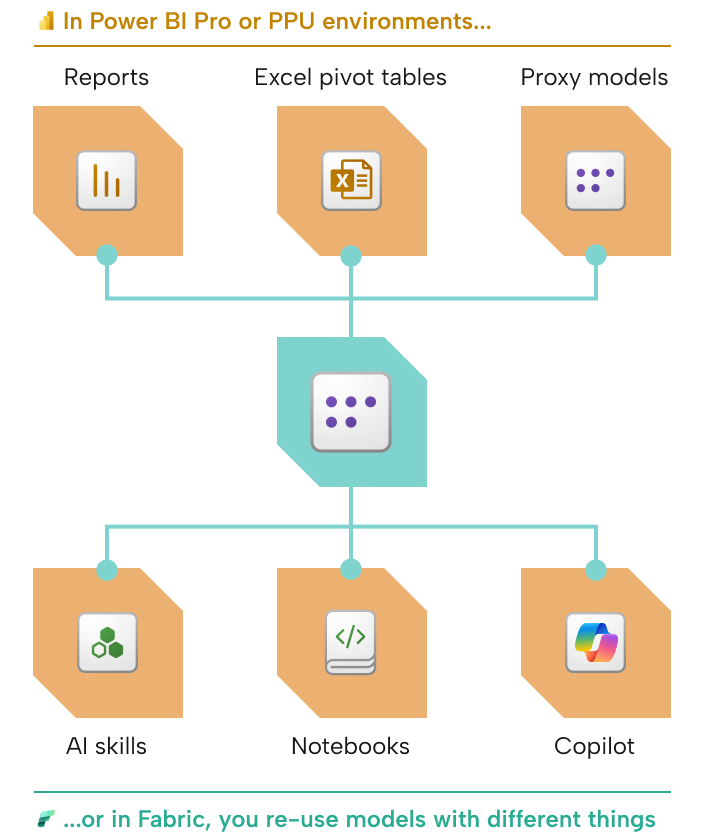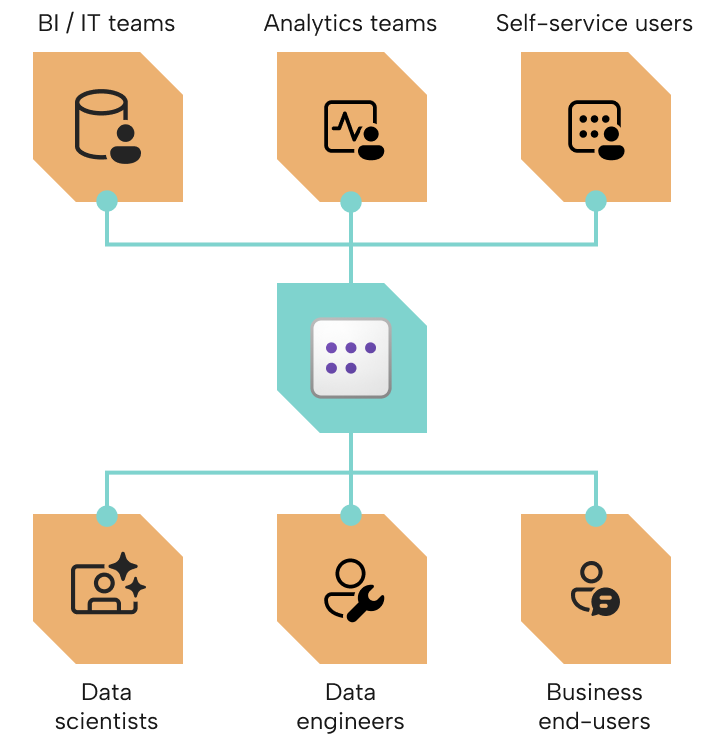Semantic models (previously known as Power BI datasets, Cubes or Tabular Models) are one of the most important parts of Microsoft Fabric. They contain business logic and calculations that many different teams and individuals need. Semantic models don't just support technical artifacts for reporting and analytics; they support business-critical decision-making and actions.
Semantic models are how most business users will interface with data, be it via visuals in reports, natural language prompts with generative AI, or exploratory and ad hoc analyses in other tools. When someone answers a question or a problem with data, most of the time, that information will arrive from a query to a semantic model.
Semantic models aren't just a powerful, re-usable toolbox; they are strategic assets critical for an organization to get the most from data, analytics, and AI (including LLMs and AI agents). Good semantic models can help you create good reports, analyses, and tools, which in turn can help you achieve organizational business objectives. At Tabular Editor, we see the semantic model as the central nervous system of analytics; the brain that takes data input and processes it into meaningful output that leads to decisions, actions, and purposeful change.
.png?width=1200&height=627&name=fig-1-brain%20(2).png)
In this short article, we explain the strategic importance of a semantic model; why it is so important and so powerful. We focus on the semantic models in Power BI and Microsoft Fabric, because they are positioned so strongly, there. However, the underlying principles and considerations here apply to semantic models in other technologies, too.
What is a semantic model?
Semantic models give meaning to your data by modelling a real-world process—such as sales, headcount, or demand planning—with dimensions (descriptive attributes to group and filter data), facts (quantitative attributes to measure), and other business logic or calculations. Alone, data points do not have a particular meaning. Consider the following example data points; which alone, these data points read as simply just numbers and letters:

It’s not until we structure these data points in a logical and purposeful way that we can appreciate the data represents a meaning. For instance, 0001026990 is a customer code, and it represents a customer dimension, and all the various attributes that go with it, like its key account, and other information.
This meaning exists within the context of a real-world process. In this case, a sales process, where customer and product dimensions describe sales data, like the quantity sold. We structure our data to represent that process functionally, typically by creating a star schema model design.

For instance, we create dimension tables for qualitative attributes and relate them to fact tables and aggregate quantitative attributes with calculations. These data structures form the basis of our semantic model; we are modelling the underlying business process that we are reporting on.

Why is a semantic model important?
As we discuss above, a semantic model is important, not just for technical reasons, but also for reasons that relate to people and processes; your business.
You re-use semantic models for multiple reports and different analytics
A semantic model doesn't exist to support a single report or dashboard. Rather, semantic models are re-usable toolboxes that can support multiple views and scenarios for using the same information. For instance, you can create multiple reports that connect to and use a shared semantic model. Then, you can publish those reports to different workspaces, package them in different apps, and share them with different audiences. This is valuable because you do not necessarily create new data models to answer new questions; you can just re-use your semantic model, saving you time and cost.
Aside from reports, you can also re-use semantic models with other analytical tools as well, from Excel pivot tables and proxy models in Power BI, to AI skills, notebooks, and Copilot in Fabric:

Much like a brain, the semantic model receives data from various inputs (like data sources) and through processing (like calculations), and it then turns that information into meaningful signals used by functional downstream units.
In summary, semantic models can be re-used by different things. Because of this, they can be leveraged by different people.
Different people can re-use semantic models
Semantic models aren't just used by different technical artifacts in an organization, but also by different teams and individuals. Different people can connect to and use the same semantic model to support different scenarios and answer different questions. This means that your semantic model is a multi-purpose hub for data and business logic, feeding different people, profiles, and even AI.

- Central BI or IT teams can create centralized reports or dashboards to distribute to large audiences. They might use metric sets to increase the discoverability of certain measures from different models by people who want to perform their own analyses.
- Decentralized analytics teams can create their own reports focused on a specific perspective, and can potentially enrich existing models with composite (or proxy) models that add additional data and calculations to the original models.
- Self-service users can connect to the semantic model for ad hoc analysis in explorations, reports, or Excel pivot tables.
- Data scientists and analysts can use the semantic model for advanced analytics scenarios by using notebooks, AI skills, and more.
- Business users see the data in their own reports, but can also explore it in Power BI, Excel, or by using natural language with Copilot.
These are just a few examples, but the same semantic model could support all of these segments (and more). Of course, the more people and scenarios that use the model, the more effort needs to go into its development and validation.
A good report requires a good semantic model
A semantic model doesn't just provide data to a report, but also the important functionality in the report. You can't get impactful and actionable visualizations unless you have a semantic model behind them. Filtering and other interactive operations in a report are a direct, functional result of the semantic model. Common reporting functionalities like filtering data, currency conversion, and measure selection are shown in the report, but derive from the model.
A poor semantic model will lead to inaccurate, unreliable, and slow reports. Even the best designs can quickly be rendered useless when report and dashboard creators neglect good model design or create unoptimized calculations. Alternatively, report creators might even become frustrated that the data model doesn't support a particular chart design or reporting functionality.
The semantic model is like the brain in this regard because form follows function. Your brain doesn’t just provide information to the other parts of your body, but also orchestrates a myriad of functions, many of which happen all at once, without you even knowing. Your heart beats, your breath inhales, your eyes move… these downstream organs need the brain to perform their function. Similar to the user of a report, you only tend to notice when things go wrong.
AI can use semantic models as context and a data source for answering data questions
Generative AI and large language models (LLMs) are nascent technology that continue to evolve (and are doing so quite quickly). However, many are already exploring the possibilities of using LLMs with semantic models. These tools can use the model schema and metadata to retrieve relevant context and generate queries against the model in response to user prompts in natural language.
Like a brain, models are important and complex
Much like a brain, semantic models have a lot of complexity:
- They take significant time and effort to design, make, and maintain.
- Different models have common elements (like date tables and certain patterns), but ultimately, each model is unique and complex in their own way, like the processes that they represent.
- They can be difficult to troubleshoot when there is a problem since there are so many inter-connected parts and pieces, and intersecting layers that might be the problem.
- They must always be reliable, secure, accurate, and performant.
At Tabular Editor, we appreciate and respect the complexity that exists in a semantic model, and how much effort that takes to manage for the people who build it. Having built and managed many semantic models ourselves, we know where developers lose time, struggle, and get frustrated. That's why our goal is to give developers the tools and resources to address these problems and pain points in practical ways.
- Enhance the productivity of professionals by reducing the time and effort of data modelling.
- Helping people re-use important objects and patterns in models, and cut through complexity.
- Identify issues quickly, efficiently, and pro-actively.
- Ensure professionals can prioritize quality without compromising efficiency.
In future articles, videos, and trainings, we'll explain how you can build better data models faster, not just in Tabular Editor, but also with the help of new tools, like:
- TMDL view in Power BI, a new functionality which allows semantic model developers to make model changes with code, which can improve efficiency for some tasks, even without third-party tools.
- Semantic Link Labs, a package that Power BI professionals can use in code notebooks in Fabric to scale tasks and enhance productivity, dramatically.
- Generative AI, including Copilot and LLMs, which enable people to get AI assistance generating code or creating novel, natural language experiences to engage with data.
In the meantime, if you want to save time and improve your semantic models, we have lots of blog posts and learning modules available at tabulareditor.com.
In conclusion
Semantic models have always been important, but that seems to only become more true as technology progresses and evolves. They are re-usable, strategic assets which help you perform and scale analytics, and use data to support business processes, answer questions, and address problems. Therefore, you need to ensure that your semantic models are good quality. Since semantic models are complex, with many intersecting parts and possible configurations or scenarios, this likely means that you can benefit from additional, specialized tools, applications, and processes.
At Tabular Editor, we think that semantic models and their developers deserve the best. When it comes to a semantic model, we think that there's no compromise for quality.
After all, if a semantic model is the brain of analytics in your organization, would you compromise on your brain?
